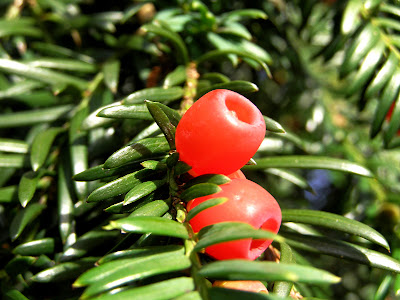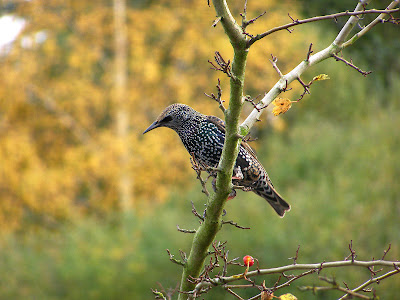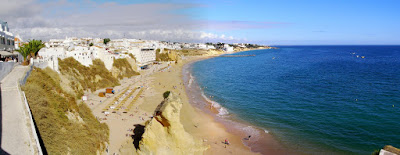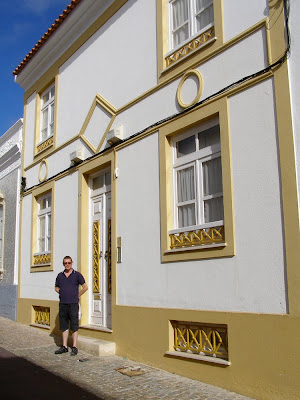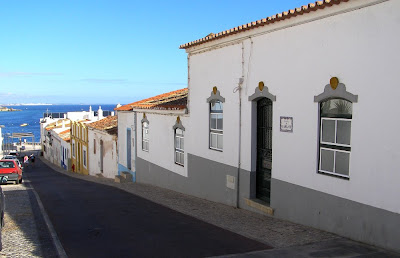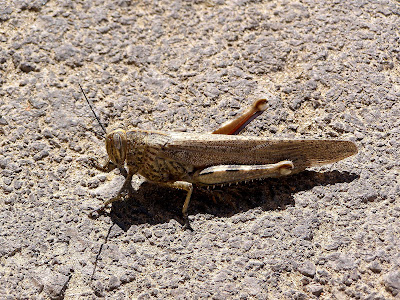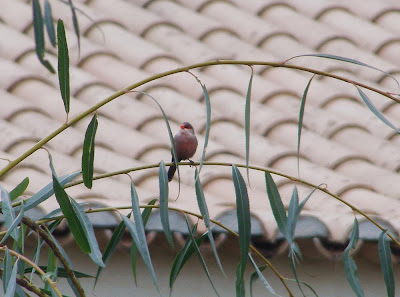What an absolute delight it was to see some of the colours yesterday, growing around the site of Shipley Hall. Among the best were these jewel-like berries of the Yew tree (Taxus baccata).
I said 'berries' but in fact they are a modified cone, the Yew being a coniferous tree. Widely grown in and around graveyards, possibly because of its longevity and supposed connection to 'eternal life'. It is more probable that they were planted in graveyards because their branches resemble palm fronds and were then used in Palm Sunday services.
Almost all of the tree is poisonous, with the exception of the bright red 'aril' surrounding the seed. This is deliberately juicy and good to eat for the birds which ingest them by the hundred.
The wood of the Yew tree has been used for thousands of years to make bows and arrows. A Yew spear-head of some 450,000 years old was found in Essex in 1911. That most feared item of Medieval warfare, the Longbow, was made of Yew wood with the heartwood on the inside (the middle) of the bow and sapwood on the outside giving both strength and flexibility.
Lastly for today, a picture of an Acer, also found in the old gardens of Shipley Hall. Its redness was almost glowing against the greens and yellows of the Autumn season and made a perfect backdrop for anyone who would sit on the bench in front if it.
Welcome to my blog. Don't expect anything too high-tech or flashy, this is simply a 'diary' to share some of my photos, thoughts and observations - with a particular bias towards the natural world and the countryside around my home.
Sunday 31 October 2010
Saturday 30 October 2010
The Birds
Yesterday afternoon, we were treated to a spectacle of almost Biblical proportions. In a scene reminiscent of a Daphne Du Maurier story and Hitchcock film, a flock of Starlings (Sternus vulgaris) decided to descend upon our front garden, the grass verges opposite our house and, most particularly, the fat-ball feeder in our tree. This picture is a composite of two taken side-by-side and joined together. The second photo was taken, just as the flock took to the air.
I have counted over 400 birds in this picture and as they all took flight and headed for our rooftop the skies darkened with their wings - a fabulous sight. We were glad they didn't all decide to land on our tree at once as it would never have stood up to them. Starlings are such well known birds, it is easy to overlook just how beautiful they are.
The glossy greens and purples of their plumage is really only seen at close range and in good light, but what a joy it is to see.
At this time of year, adult Starlings are dressed in their new, Winter plumage and are bedecked with white spots, crisp and clean-looking before they begin to fade as the Winter months pass.
Still very common despite a 66% drop in numbers since the 1970's, they form large, noisy flocks especially late in the day when looking for a communal roost. Many thousands have been witnessed in one whirling, sinuous constantly-moving group. The largest flock ever reported was one of a staggering 72,000,000 individuals in a Swiss forest during the Winter of 1952/3. Makes our flock of a few hundred seem insignificant, but I wouldn't want to provide fat-balls for 72 million!
I have counted over 400 birds in this picture and as they all took flight and headed for our rooftop the skies darkened with their wings - a fabulous sight. We were glad they didn't all decide to land on our tree at once as it would never have stood up to them. Starlings are such well known birds, it is easy to overlook just how beautiful they are.
The glossy greens and purples of their plumage is really only seen at close range and in good light, but what a joy it is to see.
At this time of year, adult Starlings are dressed in their new, Winter plumage and are bedecked with white spots, crisp and clean-looking before they begin to fade as the Winter months pass.
Still very common despite a 66% drop in numbers since the 1970's, they form large, noisy flocks especially late in the day when looking for a communal roost. Many thousands have been witnessed in one whirling, sinuous constantly-moving group. The largest flock ever reported was one of a staggering 72,000,000 individuals in a Swiss forest during the Winter of 1952/3. Makes our flock of a few hundred seem insignificant, but I wouldn't want to provide fat-balls for 72 million!
Friday 29 October 2010
Dull
Another dull day and Malcolm and I set out this morning without much hope of staying dry. I took along a large umbrella 'just in case', but in the end, we didn't need it. The clouds were scudding across the sky in the strong southerly winds which were doing their best to knock of as many Autumn leaves as it could. Following news that there has been a large influx of Waxwings (Bombycilla garrulus) in recent days, we have been keeping our eyes well open on the lookout for them. I have never seen a Waxwing but would love to do so. Oh well, we'll keep looking at the berry-laden bushes and trees, ever hopeful. These bright berries belong to the Guelder-rose (Viburnum opulus).
More about the Waxwings can be seen HERE.
Thursday 28 October 2010
More Autumn Colour
A walk past Shipley Lake and through the woods which once formed the drive from Cotmanhay Lodge to the Old Hall, supplied us with some lovely Autumn colours. Lots of Maple trees always ensure the best in golden hues.
Lastly, a tree which showed a little less yellow and a bit more red in its make-up. The leaves of these Cherry trees hung vertically from the branches like musical notes from a stave as the sun shone through them.
It is a strange thought that the colours we see in Autumn, were there all the time. They were just 'overwritten' by the green of the chlorophyll. As the leaves lose this energy-producing, green pigment, the yellows, reds and all those other Autumn colours, begin to make themselves seen.
It's not just the Maples which show some attractive colours. These Silver Birches are also showing the yellows and rusty-red hues among those leaves which are still hanging on to their green.
Next to show its true colours were the Oaks. Once again yellow seems to be the dominant colour when the green has faded.Lastly, a tree which showed a little less yellow and a bit more red in its make-up. The leaves of these Cherry trees hung vertically from the branches like musical notes from a stave as the sun shone through them.
Wednesday 27 October 2010
View from...
The view from our front windows has been enhanced in the past few weeks by the appearance of several 'new' species of bird visiting the Hawthorn tree in our front garden. I mentioned the pair of Goldcrests seen for the first time yesterday. I am still hopeful of getting a picture of them although I haven't seen them today but, we have also had a pair of Coal Tits (Periparus ater) visiting the branches over the past week or so. These have proven equally difficult to capture on camera. The last few mornings have seen a pair of Chaffinches (Fringilla coelebs) visiting us. Not an uncommon sight by any means, but I think a first for our tree.
One of Britain's most common breeding birds, Chaffinch numbers hit about 6,000,000 breeding pairs. It's common name comes from it eating spilled grain left in farmyards, literally a 'chaff' finch. It's scientific name 'Coelebs' comes from the Latin for 'bachelor' and refers to the bird's tendency to form single-sex flocks. When Swedish naturalist Carl Linnaeus (who devised the system of Latin names for flora and fauna in the 18th century) was naming the Chaffinch, he saw only flocks of male birds in his country during the Winter, so thought they must all be 'bachelors'.
The Blue Tits (Cyanistes caeruleus) are still quite common in our tree with several vying for position on the fat-balls with the Sparrows each morning.
One of Britain's most common breeding birds, Chaffinch numbers hit about 6,000,000 breeding pairs. It's common name comes from it eating spilled grain left in farmyards, literally a 'chaff' finch. It's scientific name 'Coelebs' comes from the Latin for 'bachelor' and refers to the bird's tendency to form single-sex flocks. When Swedish naturalist Carl Linnaeus (who devised the system of Latin names for flora and fauna in the 18th century) was naming the Chaffinch, he saw only flocks of male birds in his country during the Winter, so thought they must all be 'bachelors'.
The Blue Tits (Cyanistes caeruleus) are still quite common in our tree with several vying for position on the fat-balls with the Sparrows each morning.
Tuesday 26 October 2010
Rotten!
Getting up this morning, we were presented with a thoroughly rotten day. Rain was beginning to fall, the wind was getting up and it was still dark, just the sort of day for staying in bed. But, looking out the window at the bird feeder in the Hawthorn, I was delighted to see all the small birds flitting to and fro in search of a bite to eat. Great Tits, Blue Tits, House Sparrows, a Blackbird, Dunnocks and a Robin were all present as usual, but then, did my eyes deceive me? A pair of Goldcrests (Regulus regulus) suddenly appeared in the branches of the tree. Britain's smallest bird! And a pair of them! I tried to get a photo of them, but have been unsuccessful so far. Rest assured, I shall keep trying.
I had more photographic success last night as the moon rose over the hedgerow opposite, a layer of thin, low cloud hung in the sky below the moon giving a look of the sea.
An exposure of 15 seconds was enough to capture the moon-illuminated cloud, but somewhat overexposed the moon itself. Click the image for the larger picture and you may also be able to see some of the stars which were shining bravely before the clouds moved in, bringing the rain I mentioned at the beginning.
I had more photographic success last night as the moon rose over the hedgerow opposite, a layer of thin, low cloud hung in the sky below the moon giving a look of the sea.
An exposure of 15 seconds was enough to capture the moon-illuminated cloud, but somewhat overexposed the moon itself. Click the image for the larger picture and you may also be able to see some of the stars which were shining bravely before the clouds moved in, bringing the rain I mentioned at the beginning.
Monday 25 October 2010
La Stupenda
So, the world has lost one of the greatest voices ever heard. Dame Joan Sutherland died on 10th October at the age of 83. Anyone who knows me will know how I love opera and especially a well-executed coloratura soprano voice - Dame Joan had the the best voice by a very, very long way. Just listen to her interpretation of that most dramatic (and vicious) of women, Princess Turandot in Puccini's opera. Here, singing In Questa Reggia (In this palace) in which Turandot explains why she behaves in the way she does to her suitors. Listen to the soaring, powerful and magnificent 'high C' at the end (in duet with Pavarotti).... If that doesn't grab you by the back of the neck, I don't know what would! Click Here for a translation of the libretto if you don't know the story. (Don't listen Malcolm!)
Sunday 24 October 2010
Swimmers
Walking around 'Swan Lake', we were being eyed by the ducks, geese and coots in case we had some bread for them. Among these little 'beggers' were a handful of Black-headed Gulls (Larus ridibundus). In their winter plumage it is difficult to see where they get their name. Come to think about it, it's also difficult to see why they are called Black-headed even in their breeding plumage - their heads are brown, not black! But in Winter, the coloured head is reduced to a small spot of brownish grey behind the eye.
Well known in the UK, their numbers are thought to be around 138,000 breeding pairs but more fly in from the continent to spend the Winter, boosting numbers to over 1,600,000. This one is a first-winter juvenile as you can see from the remaining colouring on it's wings.
Also well known for their noisy squabbling, the name 'Seagull' is a bit of a misnomer as it is much more common inland. Especially anywhere it is likely to find food discarded by we humans. This is an adult bird and shows how beautiful they are when you take a moment to look.
An increasing population of domestic ducks seem to be taking up residence on the lake. Interbreeding with Mallards, they are producing some wonderful colour variations, although they all seem to be keeping their huge size. The white ones especially, are at least twice the size of the biggest Mallards and they all seem to keep together, not integrating much with the wild ducks.
Well known in the UK, their numbers are thought to be around 138,000 breeding pairs but more fly in from the continent to spend the Winter, boosting numbers to over 1,600,000. This one is a first-winter juvenile as you can see from the remaining colouring on it's wings.
Also well known for their noisy squabbling, the name 'Seagull' is a bit of a misnomer as it is much more common inland. Especially anywhere it is likely to find food discarded by we humans. This is an adult bird and shows how beautiful they are when you take a moment to look.
An increasing population of domestic ducks seem to be taking up residence on the lake. Interbreeding with Mallards, they are producing some wonderful colour variations, although they all seem to be keeping their huge size. The white ones especially, are at least twice the size of the biggest Mallards and they all seem to keep together, not integrating much with the wild ducks.
Saturday 23 October 2010
Closer to home
Leaving the pictures of Portugal for now, we return to some photos taken a little closer to home. We have not ventured out this morning as it looks like rain, but yesterday, the sun was shining and it was a beautiful, Autumn morning for a stroll. Looking across Manor Floods, the colour of the trees opposite, was reflected in the still water, disturbed only by a couple of Coots diving for their breakfast.
Taking a walk in the other direction, towards Shipley Hill, we were presented with more colour. Not as rich or as varied as in previous years, but still well worth stopping to take it all in.
Further up the hill and the magnificent, old Beech tree which stands looking out over the countryside to the North and over the town, is rapidly losing its leaves, but there are still enough to provide a colourful scene.
This is a truly beautiful tree and warrants more pictures (and indeed I have taken many in the past). This one taken from beneath its branches, looking towards the lake.
Taking a walk in the other direction, towards Shipley Hill, we were presented with more colour. Not as rich or as varied as in previous years, but still well worth stopping to take it all in.
Further up the hill and the magnificent, old Beech tree which stands looking out over the countryside to the North and over the town, is rapidly losing its leaves, but there are still enough to provide a colourful scene.
This is a truly beautiful tree and warrants more pictures (and indeed I have taken many in the past). This one taken from beneath its branches, looking towards the lake.
Friday 22 October 2010
Storm clouds
We had the benefit of some wonderful skies while in Portugal. The windy and 'changeable' weather we had during the middle weekend, meant that the clouds piled in from the Atlantic and some were quite stunning.
Even when it looked like we were about to be drenched, there was a certain dramatic quality to the sky which held your attention. Soon after taking this shot, we were indeed caught in a short, sharp downpour.
The early evenings afforded us some wonderful spectacles of colour and light, as the storm clouds formed.
A strange, peach-coloured light bathed us one evening as the clouds were illuminated seemingly from within by the late sunshine.
Even when it looked like we were about to be drenched, there was a certain dramatic quality to the sky which held your attention. Soon after taking this shot, we were indeed caught in a short, sharp downpour.
The early evenings afforded us some wonderful spectacles of colour and light, as the storm clouds formed.
A strange, peach-coloured light bathed us one evening as the clouds were illuminated seemingly from within by the late sunshine.
Spectacular !
When all calmed down again, the sunsets were still noteworthy and bathed us in a golden light, rounding off a lovely day and promising another warm one to follow.
Thursday 21 October 2010
Odds and ends
It's now a week since we got back from our Portuguese trip and, having had a rather chilly walk around Shipley Hill this morning, the warm sunshine of the Algarve seems a lot more distant.
One of the most exotic sights we were privileged to see were the Greater Flamingos (Phoenicopterus roseus) which live on the Salgados Wetlands.
Flamingos are extraordinary birds and these are the largest species of the family. Standing up to 5ft tall on their spindly legs, they feed in shallow water holding their heads upside down and filtering tiny animals from the muddy water. Greater Flamingos are also very long lived - or at least they are if not predated in the wild. The oldest known specimen is to be found in Adelaide Zoo, Australia and is at least 77 years old!
Another exotic species to be found within a short walk of where we were staying, was a small tree flowering along the roadside. The Jacaranda (Jacaranda mimosifolia) has some beautiful, blue/purple flowers.
The Jacaranda is a sub-tropical species from South America, but is widely planted in parts of the Mediterranean for its long-lasting flowers and feathery leaves. These leaves give rise to its other common name of 'Fern Tree'.
Separating the wetlands from the sea, were some extensive sand dunes. Dunes are an increasingly rare habitat these days as we tend to like to build holiday resorts all over them. These dunes were at least protected from too much disturbance by the construction of wooden walkways across them.
One of the most exotic sights we were privileged to see were the Greater Flamingos (Phoenicopterus roseus) which live on the Salgados Wetlands.
Flamingos are extraordinary birds and these are the largest species of the family. Standing up to 5ft tall on their spindly legs, they feed in shallow water holding their heads upside down and filtering tiny animals from the muddy water. Greater Flamingos are also very long lived - or at least they are if not predated in the wild. The oldest known specimen is to be found in Adelaide Zoo, Australia and is at least 77 years old!
Another exotic species to be found within a short walk of where we were staying, was a small tree flowering along the roadside. The Jacaranda (Jacaranda mimosifolia) has some beautiful, blue/purple flowers.
The Jacaranda is a sub-tropical species from South America, but is widely planted in parts of the Mediterranean for its long-lasting flowers and feathery leaves. These leaves give rise to its other common name of 'Fern Tree'.
Separating the wetlands from the sea, were some extensive sand dunes. Dunes are an increasingly rare habitat these days as we tend to like to build holiday resorts all over them. These dunes were at least protected from too much disturbance by the construction of wooden walkways across them.
These dunes also provided a great place for the Curry-scented everlasting plants (Helichrysum stoechas) which formed clumps of dessicated foliage all over and filled the air with their perfume (Poor Malcolm doesn't like the smell of curry, so he didn't think much to them).
When the sea is rough, it is able to breach the dunes in places, flooding into the fresh waters of the wetlands, turning them brackish. The introduction of salt water had a strange effect on the fish of the wetlands as they all began to get 'excited' and leap from the water. Here you can see the sea breaching the dunes as each large wave broke over the sand.Wednesday 20 October 2010
Albufeira
I have already mentioned our walk into the nearby town of Albufeira and I have posted some pictures of the Marina there. Today I thought it would be nice to see some more of the town (actually classed as a city).
The name Albufeira comes from an Arabic word Al-Buhera meaning 'castle of the sea', but there have been people living in the area since Neolithic times. The Romans called the town Baltum.
There are very few - if any - buildings in the city more than 250 years old because the city was almost completely destroyed by an earthquake and subsequent tidal flood in 1755. By the 19th century, fishing had become one of the most important sources of income. Many old fishermen's cottages can still be found in the narrow side-streets, away from the main tourist parts of the city. These are often very ornately covered in glazed tiles.
We came across these rather grand buildings as we walked out of the city, up and over the hill which separates the main town from the harbour. This house was particularly well decorated by the addition of a good-looking chap in front!!!
Looking down towards the mouth of the harbour, you could see the man-made harbour walls protecting the inlet to the marina previously mentioned.
Up here, more evidence of the former and much smaller fishing village which was Albufeira before the tourists arrived.
It all goes to show, when visiting new parts of the world, it's always best to try to get away from the main tourist areas and see what can be found down the side streets.
The name Albufeira comes from an Arabic word Al-Buhera meaning 'castle of the sea', but there have been people living in the area since Neolithic times. The Romans called the town Baltum.
There are very few - if any - buildings in the city more than 250 years old because the city was almost completely destroyed by an earthquake and subsequent tidal flood in 1755. By the 19th century, fishing had become one of the most important sources of income. Many old fishermen's cottages can still be found in the narrow side-streets, away from the main tourist parts of the city. These are often very ornately covered in glazed tiles.
We came across these rather grand buildings as we walked out of the city, up and over the hill which separates the main town from the harbour. This house was particularly well decorated by the addition of a good-looking chap in front!!!
Looking down towards the mouth of the harbour, you could see the man-made harbour walls protecting the inlet to the marina previously mentioned.
Up here, more evidence of the former and much smaller fishing village which was Albufeira before the tourists arrived.
It all goes to show, when visiting new parts of the world, it's always best to try to get away from the main tourist areas and see what can be found down the side streets.
Tuesday 19 October 2010
More 'ticks'
Some more ticks today for my life lists. Starting with another bird which I had previously not seen, this time a group of three Caspian Terns (Hydroprogne caspia, formerly Sterna caspia). These enormous members of the Tern family were found standing on a small island in the wetlands. They were also a long way from us and keeping their distance, so taking a picture was rather tricky. The tall bird standing with them on the left, was a Spoonbill (Platalea leucorodia) not new to me, but a big 'tick' for Malcolm. Both Caspian Terns and Spoonbills are threatened species in Europe due to loss of habitat. So much wetland and marsh has been drained and built on in the recent past that birds which depend on these sites are under huge pressure. As if they're not under enough pressure, Malcolm decided to rename the Spoonbills 'Tablespoon-faced dickie birds'......! What would you do with him?
Next, a plant species new to me. Growing in the sand dunes between the wetlands and the sea were lots of these Sea Daffodils (Pancratium maritimum).
The name 'Pancratium' comes from the Greek meaning "Strength" as the plant is able to grow in extremely hot, dry conditions which would kill many other plants. They can do this because the bulbs are deeply buried so the roots can reach more fertile soils.
A couple of insects next. The first was spotted on the road by Malcolm as we walked to Albufeira. This large specimen is an Egyptian Grasshopper (Anacridium aegyptium). About 3" long, it was quite an impressive insect and quite common around Southern Europe and the Mediterranean. Close inspection reveals the fantastic striped eyes. They have been recorded in Britain, but prefer the more warm, dry habitats.
An invasive and unwelcome species next. A Red Palm Weevil (Rhynchophorus ferrugineus).
This insect is the most dangerous and deadly pest of Date, Coconut, Oil and Sago Palm trees and has been introduced to Europe from it's native Southern Asia and Melanesia. As with most alien species, they have spread by human intervention as we have transported palms and palm products infected with these insects, all over the world. At about 2" long, it too was an imposing little creature as it scuttled across the footpath.
Lastly for today, a four legged animal and a far more attractive one too. This delightful creature goes by the name of Large Psammodromus Lizard (Psammodromus algirus). Still fairly common in many Southern European countries especially around the Med' it too is under threat from habitat loss (we humans have a lot to answer for). This one was found sunning itself on a rock by the sea and didn't seem too bothered as I took it's photo. What a little stunner!
Next, a plant species new to me. Growing in the sand dunes between the wetlands and the sea were lots of these Sea Daffodils (Pancratium maritimum).
The name 'Pancratium' comes from the Greek meaning "Strength" as the plant is able to grow in extremely hot, dry conditions which would kill many other plants. They can do this because the bulbs are deeply buried so the roots can reach more fertile soils.
A couple of insects next. The first was spotted on the road by Malcolm as we walked to Albufeira. This large specimen is an Egyptian Grasshopper (Anacridium aegyptium). About 3" long, it was quite an impressive insect and quite common around Southern Europe and the Mediterranean. Close inspection reveals the fantastic striped eyes. They have been recorded in Britain, but prefer the more warm, dry habitats.
An invasive and unwelcome species next. A Red Palm Weevil (Rhynchophorus ferrugineus).
This insect is the most dangerous and deadly pest of Date, Coconut, Oil and Sago Palm trees and has been introduced to Europe from it's native Southern Asia and Melanesia. As with most alien species, they have spread by human intervention as we have transported palms and palm products infected with these insects, all over the world. At about 2" long, it too was an imposing little creature as it scuttled across the footpath.
Lastly for today, a four legged animal and a far more attractive one too. This delightful creature goes by the name of Large Psammodromus Lizard (Psammodromus algirus). Still fairly common in many Southern European countries especially around the Med' it too is under threat from habitat loss (we humans have a lot to answer for). This one was found sunning itself on a rock by the sea and didn't seem too bothered as I took it's photo. What a little stunner!
Monday 18 October 2010
Birdies
It's always nice to be able to add a new species to your life list. I must be a bit odd as I have several 'life lists', for birds, for plants, for invertebrates, for mammals and for 'others'. Our trip to Portugal has added to most of these lists. We will start with the one which has had the biggest gain; the Birds list.
Staying near to an area of wetland is always a good start if you want to see birds as they are usually very rich in species and numbers. Staying as we were, next to the Salgados Wetlands, we were not disappointed. The first new species was also the smallest we saw. A little bird with a big name - in fact two big names - A Fan-tailed Warbler (Cisticola juncidis).
It may be a bit difficult to spot in amongst the dry grasses and shrubs of dunes, but that is, after all, the whole point of camouflage. I mentioned that this little bird has two names, apart from Fan-tailed Warbler, the other name it goes by is the Zitting Cisticola. Weighing only about 1/4oz and being entirely insectivorous, it can sometimes have a very difficult time during cold weather when it's food source is scarce. It is the only member of the Cisticola family of Warblers to be found in Europe. Most of it's cousins are native to the African continent.
Secondly, a slightly larger bird and one which really has no business being in Portugal. Native to Sub-Saharan Africa, the Common Waxbill (Estrilda astrild) has become resident in Portugal over the past few years and is spreading into Spain. We were lucky enough to have a small flock of about 10 individuals which regularly visited the trees next to our apartment. Always flitting about and never sitting still for more than a few seconds at a time, these handsome little finches took a lot of patience and not a little luck to capture on camera. The red markings on it's face give it the the look of wearing a mask.
Moving up the size scale just a bit more, we saw several Crested Larks (Galerida cristata) scuffling around the dry, dusty ground of the car-parks and footpaths, leaping into the air as soon as I managed to focus on them. So, these were also rather difficult to get a good 'shot' of, but here goes...
Bigger still now and a bird which blended so well into it's environment, that it was all too easy to miss. However, as we peeked over the wall which ran around the golf course nearby, I was astonished to see another 'new' bird for my list. This time, it was standing absolutely motionless on a rock by the side of a small river which ran through the greens of the golf course. A Squacco Heron (Ardeola ralloides). This a is a very small member of the Heron family measuring only about 18" tall. Wintering in Africa, they are very seldom seen further north than these Southern European and Mediterranean coasts. Pale in colour when out of breeding plumage, they show shocking, white wings when they take to the air, as this one did a few seconds later. What a beauty!
I have saved the best for last...
Crashing around the reed-beds and making strange 'mooing' noises was a large, heavily built bird, rare (indeed endangered) in Europe and nowhere very common. Related to our more familiar Moorhen, but much bigger, the Purple Swamphen (Porphyrio porphyrio subspecies porphyrio) is a sight to behold.
You can get a good idea of size when compared to the Coot next to which this one was standing. We did in fact see several Purple Swamphens (also called Purple Gallinules) while we were walking around the wetlands, never straying too far from the reed beds and always ready to scuttle off and hide among the tall stems at the first sign of threat. Purple Swamphens feed on the reeds, especially the white 'pith' within the stalks. They cut the reeds off at the base with their formidable bill, then hold them it their huge feet while nibbling the stems from the soft base upwards. They have also been known to eat eggs, small ducklings and invertebrates (especially water snails) but what a stunning bird and what a wonderful 'tick' for my list!
Staying near to an area of wetland is always a good start if you want to see birds as they are usually very rich in species and numbers. Staying as we were, next to the Salgados Wetlands, we were not disappointed. The first new species was also the smallest we saw. A little bird with a big name - in fact two big names - A Fan-tailed Warbler (Cisticola juncidis).
It may be a bit difficult to spot in amongst the dry grasses and shrubs of dunes, but that is, after all, the whole point of camouflage. I mentioned that this little bird has two names, apart from Fan-tailed Warbler, the other name it goes by is the Zitting Cisticola. Weighing only about 1/4oz and being entirely insectivorous, it can sometimes have a very difficult time during cold weather when it's food source is scarce. It is the only member of the Cisticola family of Warblers to be found in Europe. Most of it's cousins are native to the African continent.
Secondly, a slightly larger bird and one which really has no business being in Portugal. Native to Sub-Saharan Africa, the Common Waxbill (Estrilda astrild) has become resident in Portugal over the past few years and is spreading into Spain. We were lucky enough to have a small flock of about 10 individuals which regularly visited the trees next to our apartment. Always flitting about and never sitting still for more than a few seconds at a time, these handsome little finches took a lot of patience and not a little luck to capture on camera. The red markings on it's face give it the the look of wearing a mask.
Moving up the size scale just a bit more, we saw several Crested Larks (Galerida cristata) scuffling around the dry, dusty ground of the car-parks and footpaths, leaping into the air as soon as I managed to focus on them. So, these were also rather difficult to get a good 'shot' of, but here goes...
Bigger still now and a bird which blended so well into it's environment, that it was all too easy to miss. However, as we peeked over the wall which ran around the golf course nearby, I was astonished to see another 'new' bird for my list. This time, it was standing absolutely motionless on a rock by the side of a small river which ran through the greens of the golf course. A Squacco Heron (Ardeola ralloides). This a is a very small member of the Heron family measuring only about 18" tall. Wintering in Africa, they are very seldom seen further north than these Southern European and Mediterranean coasts. Pale in colour when out of breeding plumage, they show shocking, white wings when they take to the air, as this one did a few seconds later. What a beauty!
I have saved the best for last...
Crashing around the reed-beds and making strange 'mooing' noises was a large, heavily built bird, rare (indeed endangered) in Europe and nowhere very common. Related to our more familiar Moorhen, but much bigger, the Purple Swamphen (Porphyrio porphyrio subspecies porphyrio) is a sight to behold.
You can get a good idea of size when compared to the Coot next to which this one was standing. We did in fact see several Purple Swamphens (also called Purple Gallinules) while we were walking around the wetlands, never straying too far from the reed beds and always ready to scuttle off and hide among the tall stems at the first sign of threat. Purple Swamphens feed on the reeds, especially the white 'pith' within the stalks. They cut the reeds off at the base with their formidable bill, then hold them it their huge feet while nibbling the stems from the soft base upwards. They have also been known to eat eggs, small ducklings and invertebrates (especially water snails) but what a stunning bird and what a wonderful 'tick' for my list!
More new ticks tomorrow...
Subscribe to:
Posts (Atom)

